Chances are you were once interested in SendGrid for its reputation as a transactional email service provider or SMTP (Simple Mail Transfer Protocol) service provider.
While it’s true that big-name brands are still putting aside leaving the platform, SendGrid has been a questionable choice for small to medium businesses (SMBs) for a while now.
Read on to learn about the best SendGrid alternatives and what they have to offer. But before we start, let’s see why people consider switching from SendGrid in the first place.
Why Consider SendGrid Alternatives?
SendGrid might look attractive for its famous clients. After all, if something like Yelp is using it, it must be good, right?
Unfortunately, SendGrid seems to keep riding on the same wave, offering little improvements over time, prioritizing the big names, and getting rather costly.
So, if you’re looking for SendGrid-similar services that offer more innovation and value, you’ll likely find better options elsewhere.
Let’s look at some ecommerce businesses’ reasons for leaving SendGrid in more detail:
- Expensive. The essentials plan starts from a relatively high $20 per month. What you get in return is just a drop of all features;
- Only a 3-day email log. Log retention can be used in evaluating your email performance. Just three days mean you have to hurry for unsatisfactory results or pay for a 30-day log history extra to an already costly service.
- Restrictive marketing channel diversification. If you wish to explore other high-converting marketing channels like SMS messages, push notifications, or chats, you’ll need to invest in not-so-cheap add-ons.
- Unsatisfactory customer service. Many users have reported that SendGrid’s support has worsened, and their phone support (on higher plans) is often unresponsive.
- Blacklisted IPs. This one is a huge no-no in the email marketing context. If dedicated IP addresses are blacklisted, most marketing messages will go straight to the spam folder.
SendGrid Alternatives Comparison Table
Now you’ve checked each email marketing platform for transactional messages and emails, it’s time to compare each of the alternatives quickly.
Here’s a quick chart that’ll help you make an informed decision about the platform you choose.
| Cost | Monthly Emails | Free Plan | Best Feature | |
| Sender | Starts at $8/month | Up to 12,000 emails/month | Yes | Visual automation builder |
| Mailtrap | Starts at $15/month | Up to 10,000 emails/month | Yes | Actionable analytics |
| SparkPost | Starts at $20/month | Up to 50,000 emails/month | Yes | High email deliverability |
| Postmark | Starts at $15/month | Up to 10,000 emails/month | Yes | Message streams |
| Amazon SES | $0.10/1000 emails | NA | Yes | Pay-as-you-go pricing |
| Mailchimp Transactional Email | $15/month* | Up to 10,000 emails | Yes | Webhooks |
| Mailgun | $35/month | Up to 50,000 monthly emails | Yes | Inbox placement tracking |
| SMTP.com | $25/month | Up to 50,000 emails/month | No | Reputation defender |
| Brevo | $9/month | Up to 5,000 emails per month | Yes | Unlimited logs |
| HubSpot | $18/month | 5x tier contact limit for email sends | No (Free Trial Only) | CRM solution |
| ActiveCampaign | $15/month | 10x contact email send limit | No (Free Trial Only) | Dynamic content tags |
*Users have to pay for their Mailchimp plan separately, block overage charges, plus additional charges for add-ons like dedicated emails.
Best SendGrid Alternatives for Developers
If you’re searching for a SendGrid equivalent, you should consider the following tools:
1. Postmark – Best Transactional Email Service Provider
Postmark is ideal for transactional email campaigns and is designed for SaaS email marketing platforms and tech startups. It prioritizes transactional email delivery to major email clients, ensuring exceptional performance and reliability.
Best for:
- SaaS startups;
- Tech companies;
- Financial firms.

Postmark offers premade email templates to streamline communication. One interesting feature offered by the tool is message streams. It prevents email mixing, improving traffic management and deliverability. Plus, Postmark’s reliable SMTP relay server ensures fast delivery to popular email clients.
With detailed reporting and a 45-day log retention period, Postmark provides users with valuable insights into their email campaigns. Though Postmark maintains a separate infrastructure for transactional and bulk emails, it lacks standard campaign-building features.
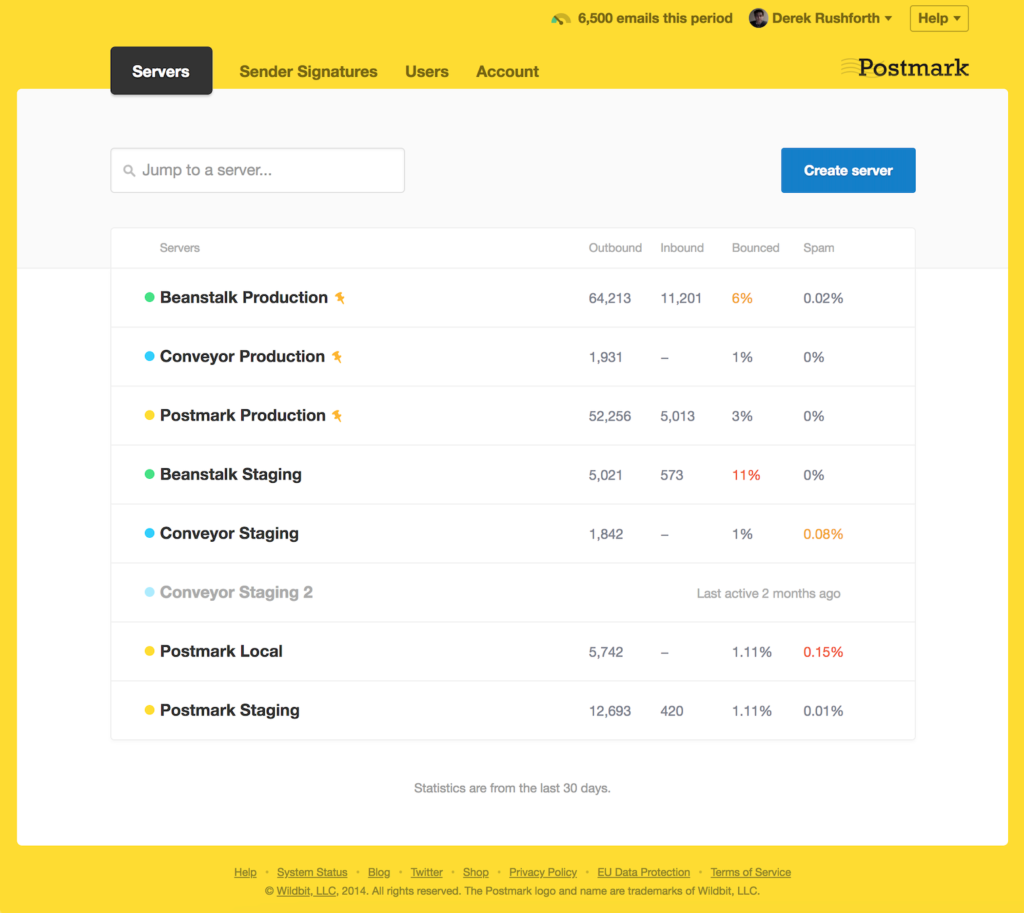
Features
- Detailed reporting;
- 45-day log retention;
- Separate infrastructure for transactional and bulk emails;
- Message Streams feature;
- Reliable SMTP server;
- Comprehensive REST APIs.
Pros & Cons
| Pros | Cons |
| Superior customer support | Lacks campaign building capabilities |
| Detailed reporting | Limited email marketing functionality |
| 45 days log retention | No user-friendly interface |
Pricing & Free Plan
| Plan | Cost | Limits |
| Basic | $15/month | Send up to 10,000 monthly emails |
| Pro | $55/month | Send up to 50,000 monthly emails |
Postmark charges an overage fee per 1000 emails whenever you exceed your plan limits. Its free developer trial allows you to send up to 100 emails monthly.
2. SparkPost – Analytics and High Deliverability
For developers seeking powerful services like SendGrid, SparkPost stands out as a top contender. This reliable email delivery service is specifically designed with developers in mind, offering flexible APIs and detailed documentation for seamless integration.
Best for:
- Online marketplaces;
- Subscription services;
- Ecommerce businesses.
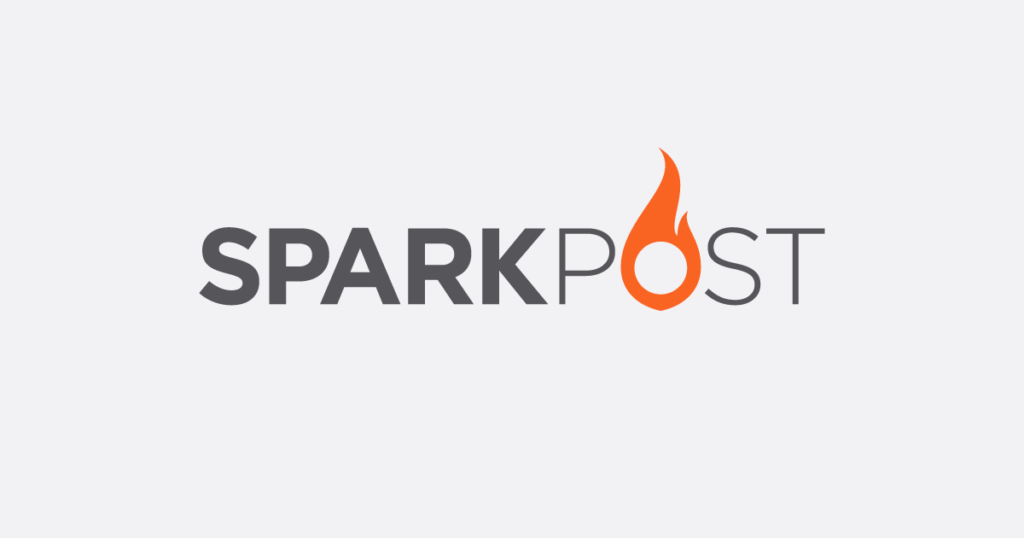
SparkPost doesn’t just deliver emails; it provides in-depth insights to optimize your campaigns. Their powerful analytics platform, aptly named SparkPost Analytics, offers granular data on deliverability, engagement, and more, empowering you to make data-driven decisions.
SparkPost is renowned for its high deliverability rates. Their dedicated infrastructure and focus on email authentication ensure your messages reach the inbox, boosting engagement and maximizing your campaign’s impact.

Key Features
- High email deliverability;
- Scalable email sending;
- Comprehensive API and integrations;
- Detailed analytics and reporting.
Pros & Cons
| Pros | Cons |
| Advanced analytics and reporting | Limited free tier |
| High deliverability | Complex API documentation |
| Extensive API integration | Unresponsive customer support |
Pricing & Free Plan
Plan
| Plan | Cost | Limits |
| Basic | $20/month | Send up to 50,000 monthly emails |
| Pro | $30/month | Send up to 100,000 monthly emails |
It offers a free plan, allowing you to send 500 emails/month for testing and development.
3. Amazon SES – Cheapest Dedicated IP Addresses
Amazon SES, standing for Simple Email Service, caters to businesses seeking a reliable and affordable solution for service emails.
Trusted by industry giants like Reddit and Netflix, SES offers core metrics, scalability and cheapest dedicated IP addresses, making it ideal for enterprises of varying sizes.
Best for:
- SaaS companies;
- Indie-creators;
- Technology startups.

While lacking advanced email marketing features, SES compensates with essential tools such as the Virtual Deliverability Manager for automated inbox optimization and a Mailbox Simulator for scenario testing.
Amazon SES stands out from its competitors, emphasizing simplicity and cost-effectiveness. It operates on a pay-as-you-go pricing model that adjusts to users’ needs, ensuring affordability.
Its authentication options, including SPF and DKIM, ensure high deliverability rates, while activity and sender reputation monitoring features enable effective email performance tracking.
With its robust infrastructure and focus on reliability, Amazon SES remains a compelling choice for businesses prioritizing affordability and scalability in their email solutions.

Features
- Core metrics tracking;
- Virtual deliverability manager;
- Mailbox simulator;
- Pay-as-you-go pricing;
- Authentication options (SPF, DKIM);
- Activity monitoring;
- Reputation monitoring.
Pros & Cons
| Pros | Cons |
| Scalability | Lack of built-in email marketing tools |
| Pay-as-you-go pricing model | Requires technical expertise for setup |
| Core metrics tracking | Limited customer support compared to some rivals |
Pricing & Free Plan
| Plan | Cost | Overages & Add ons |
| Outbound email from EC2 | $0.10/1000 emails | $0.12 per gigabyte (GB) of data in the attachments you send |
| Outbound email from non-EC2 | $0.10/1000 emails | $0.12 per gigabyte (GB) of data in the attachments you send |
| Inbound email | $0.10/1000 emails | $0.09 for every 1,000 incoming email chunks |
It offers several add-ons for customized requirements. Also, there’s a free 1-year tier allowing you to send up to 3,000 emails monthly;
4. Mailchimp Transactional – Best for Transactional Emails
Looking for services like SendGrid for your transactional email needs? Consider Mailchimp Transactional Email (formerly Mandrill). This robust alternative offers a user-friendly SMTP server, making sending and managing effective email campaigns easy.
Best for:
- Mid-market companies;
- Agencies and freelancers;
- Service-based startups.
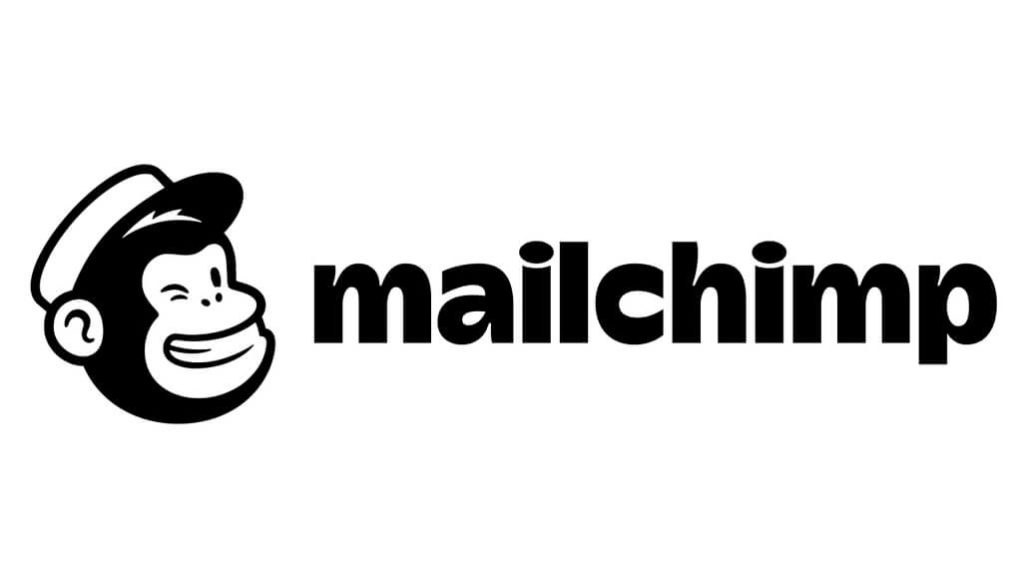
Boasting a comprehensive feature set that encompasses dynamic content, conditional rules, webhooks, click tracking, and A/B testing, Mailchimp Transactional Email caters to diverse needs for effective email communication.
It also facilitates lead generation through form and landing page builders and email segmentation features for efficient contact management. With advanced multi-step sequences available at higher-tier plans, Mailchimp Transactional Email is a versatile solution for businesses seeking a reliable platform for transactional email needs.
But when compared to better options on this list, it lacks the user-friendliness and seamlessness a business owner expects while looking for a Sendgrid alternative.

Features
- Dynamic content (merge tags);
- Conditional rules;
- Webhooks;
- Click tracking;
- A/B testing;
- SMTP server solution.
Pros & Cons
| Pros | Cons |
| Dynamic content with merge tags | Separate pricing for transactional emails |
| Conditional rules and webhooks | Limited features compared to Mailchimp platform |
| Click tracking and A/B testing | Limited customization options for transactional emails |
Pricing & Free Plan
The platform charges users based on a block system where every block is a credit of 25,000 emails. Users have to pay for their Mailchimp plan separately, block overage charges, plus additional charges for add-ons like dedicated emails.
| Cost | Limits |
| $20/block for up to 20 blocks | 1 to 500k emails |
| $18/block for up to 40 blocks | 500k to 1M emails |
| $16/block for up to 80 blocks | 1M to 2M emails |
| $14/block for up to 120 blocks | 2M to 3M emails |
Users can sign up for Mailchimp’s free plan to check the features, which support up to 500 subscribers and 1,000 monthly emails. Transactional email blocks to be paid separately.
5. Mailgun – High Email Deliverability
Mailgun is used as a white-labeled solution by many apps and startups. It offers a comprehensive suite of email deliverability tools, including inbox placement, verification, and transactional SMS capabilities.
Best for:
- App-based startups;
- Service-oriented companies;
- Solopreneurs & developers.

Mailgun integrates easily with different email marketing services, which makes it easy for non-technical people (like marketers) to start their campaigns marketers using an intuitive drag-and-drop email builder.
One key feature that sets Mailgun apart is its InboxReady toolkit. This toolkit enhances email deliverability through verification, pre-send testing, and precise inbox placement tracking.
Despite lacking dedicated email marketing tools like other alternatives, Mailgun compensates with exceptional deliverability rates. However, its lack of critical email marketing features makes it a good solution only for developers/marketers looking for a transactional email API.

Key Features
- Email API solutions;
- Email deliverability services;
- Inbox placement tracking;
- Email verification;
- SMTP relay server;
- RESTful API integration.
Pros & Cons
| Pros | Cons |
| Advanced email deliverability services | Lack of built-in email marketing tools |
| Comprehensive inbox placement tracking | Requires technical knowledge for setup |
| Transactional SMS capabilities | Pricing may not be suitable for all users |
Pricing & Free Plan
| Plan | Cost | Limits |
| Foundation | $35/month | Up to 50,000 monthly emails |
| Scale | $90/month | Up to 1,00,000 monthly emails |
Mailgun’s free plan lets you send up to 5,000 monthly emails.
6. SMTP.com – Cloud SMTP with API Integration
If you’re searching for reliable services like SendGrid, SMTP.com should be on your radar. As one of the leading cloud-based email services, they’ve built trust with over 100,000 businesses over two decades. SMTP.com provides a robust cloud-based SMTP relay and a developer-friendly API, ensuring a seamless transition and efficient solutions for your email needs.
Best for:
- Developers;
- SaaS companies;
- Large corporates.

Moving from other solution providers like SendGrid is a breeze, thanks to SMTP.com’s migration templates, designed to simplify users’ processes.
A notable feature of SMTP.com is its versatility in handling various emails, including marketing and transactional ones.
Whether remarketing campaigns, win-back emails, notifications, or order confirmations, SMTP.com supports many email types. It also includes a reputation defender tool, which identifies and suppresses invalid email addresses pre-send, ensuring list health and maintaining a positive domain and IP reputation.

Features
- Cloud-based SMTP relay;
- API integration;
- Reputation defender;
- Integration with various applications;
- Experienced support team.
Pros & Cons
| Pros | Cons |
| Cloud-based SMTP relay | Limited marketing email features |
| API integration for easy integration | Pricing may not be suitable for all businesses |
| Reputation defender for list hygiene | May require technical expertise for setup |
Pricing & Free Plan
| Plan | Cost | Limits |
| Essential | $25/month | Up to 50,000 emails/month |
| Starter | $80/month | Up to 100,000 emails/month |
| Growth | $300/month | Up to 500,000 emails/month |
| Business | $500/month | Up to 100,000 emails/month |
No free plan or trial is mentioned on the website.
SendGrid Alternatives for Marketers
Are you thinking of moving your email marketing campaigns away from SendGrid? You might find a perfect SendGrid equivalent here:
- Sender – Affordable and rich in advanced features;
- Mailtrap – User-friendly email delivery platform;
- Brevo – Good alternative for CRM features;
- HubSpot – Best in terms of feature-richness;
- ActiveCampaign – Best competitor for email templates design.
1. Sender – Affordable and Reliable for Deliverability
Sender is at the top of the list and a free SendGrid alternative, for a good reason — it’s a powerful email and SMS marketing tool with an intuitive email builder. Plus, human customer support ensures you get real solutions and don’t waste time talking to a robot.
Best for:
- Small and medium business owners;
- Ecommerce stores;
- Email marketing beginners.

Sender offers a powerful drag-and-drop email builder with a library of responsive templates + readymade design blocks. The UI is simple to navigate even for beginners.
Plus, it has all the features needed for omnichannel campaigns: a drag-and-drop email design tool, SMS/email marketing automation builder, popup creator, and smart segmentation. You get everything needed to get you going within a day (or less).

You can easily set up automation campaigns based on smart segmentation, such as those for abandoned carts, winback emails, follow-ups, and cross-selling.
Sender offers access to all the premium features, even on the free plan. So, you can scale without any hidden costs, making it a SendGrid cheaper alternative for small businesses.
Features
- Email and SMS automation;
- Smart segmentation and personalization;
- High-converting popups and forms;
- Drag-and-drop email builder with free premade templates;
- 24/7 non-robotic customer support over live chat & email.
Pros & Cons
| Pros | Cons |
| Omnichannel marketing automation builder | No landing page builder (yet) |
| Simple drag-and-drop email builder with responsive templates | Sender logo with a free plan |
| Most affordable in the market |
Pricing & Free Plan
| Plan | Cost | Limits |
| Standard Plan | Starts at $8/month | Up to 1,000 contacts and up to 12,000 emails/month |
| Professional Plan | Starts at $14/month | Up to 1,000 contacts and up to 24,000 emails/month |
Sender’s free plan supports up to 15,000 monthly emails to 2,500 subscribers. You can use all the premium features, including automation workflows, segmentation, and email builder, unlike SendGrid.
2. Mailtrap – User-Friendly Email Delivery Platform
Mailtrap is a comprehensive email marketing platform designed to streamline email campaign creation, testing, and delivery. It offers a suite of tools tailored for businesses to enhance their email marketing strategies.
Best for:
- Small to medium-sized businesses;
- Marketing teams;
- Developers.

Mailtrap provides a user-friendly drag-and-drop email builder, enabling users to craft responsive email templates without coding expertise. An HTML editor is also available for those preferring direct code manipulation. The platform’s email templates can be reused across various campaigns, ensuring design consistency and efficiency.
One notable feature is the ability to import contacts via CSV files, facilitating the creation of segmented email lists for targeted campaigns. This segmentation allows for personalized content delivery, enhancing engagement and conversion rates.
Mailtrap also offers actionable analytics, providing insights into open rates, click-through rates, and other key performance indicators. This data-driven approach enables users to optimize their email marketing strategies effectively.
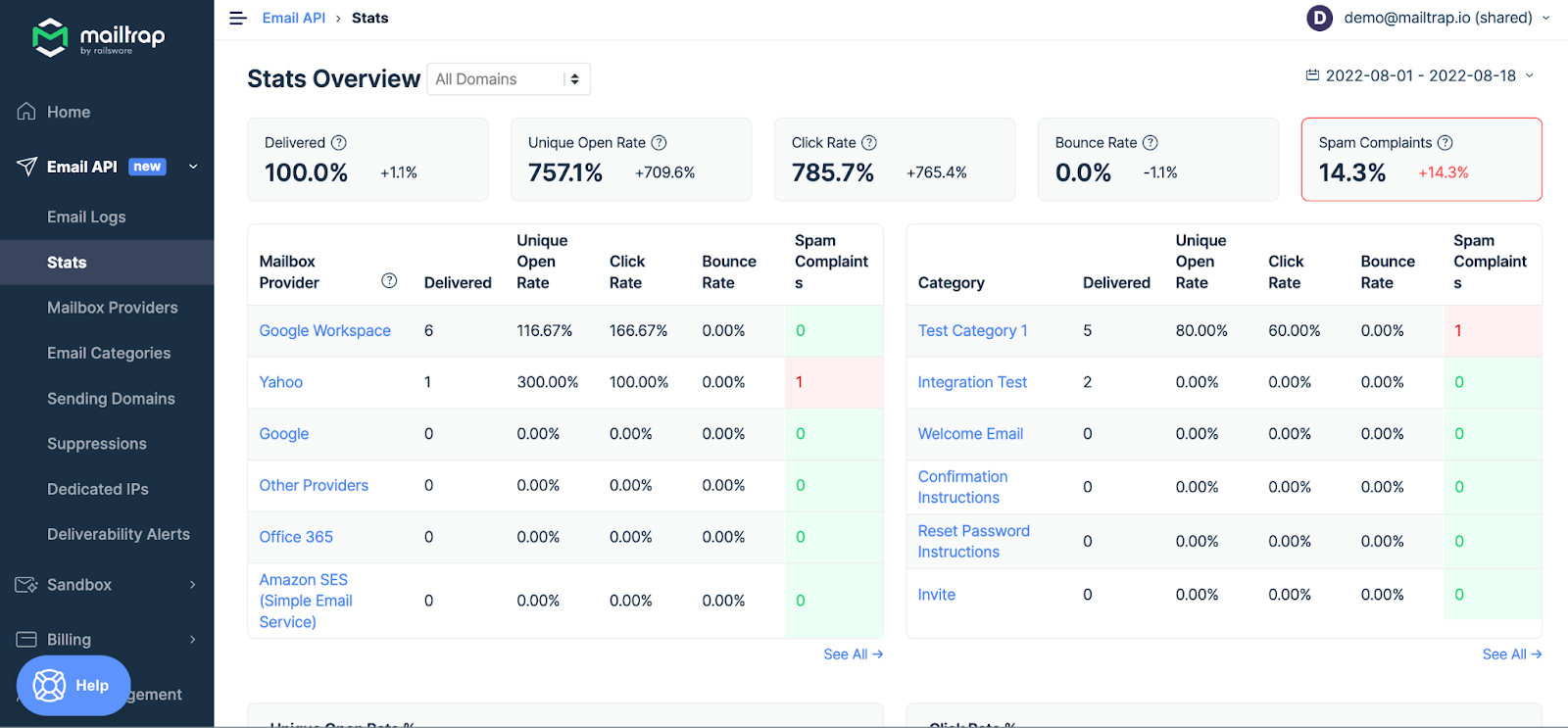
Features
- Drag-and-drop email builder;
- HTML email editor;
- Reusable email templates;
- Contact import and segmentation;
- Actionable analytics;
- SMTP and RESTful API integration.
Pros & Cons
| Pros | Cons |
| User-friendly interface | Advanced features may require a learning curve |
| Robust contact management | Limited free plan capabilities |
| Detailed analytics for performance tracking | Limited integration options |
Pricing & Free Plan
| Plan | Cost | Limits |
| Basic | $15/month | Up to 10,000 emails and 5 000 contacts |
| Business | $85/month | Up to 100,000 emails and 100 000 contacts |
| Enterprise | $750/month | Up to 1,500,000 emails and 1 500 000 contacts |
Mailtrap offers a free plan with basic features, allowing users to send up to 1,000 emails monthly. Premium plans, with advanced functionalities and higher sending limits, are available at competitive pricing.
3. Brevo – Unified Marketing and Transactional Platform
Brevo, formerly Sendinblue, is a compelling SendGrid European alternative to traditional email marketing services. It boasts extensive customer relationship management (CRM) features tailored for businesses.
Best for:
- Small business owners;
- Creators and coaches;
- Retail startups.

Unlike services like Sendgrid, Brevo keeps unlimited logs, ensuring access to the complete history of emails sent to each recipient. It also offers marketing and transactional emails via its email marketing API and SMTP relay beyond basic email delivery services.
From contact management tools to customizable newsletter signup forms, a sales CRM, and email segmentation, Brevo has many useful features. Its intuitive workflow builder empowers users to set up automated sequences, streamlining communication workflows and enhancing customer engagement.
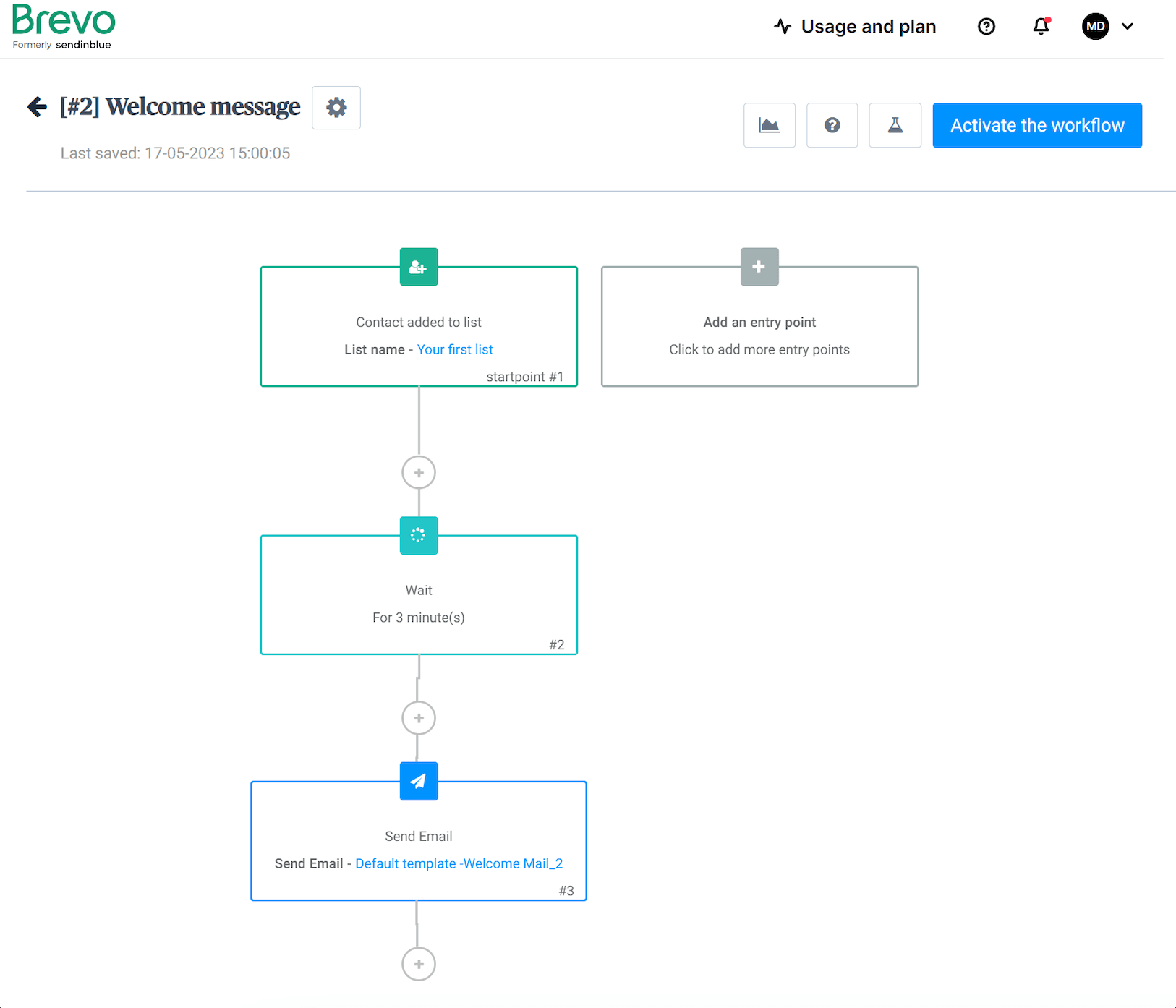
Features
- Transactional emails via email marketing API and SMTP relay;
- Automated triggers for transactional emails based on events;
- Unlimited logs for email history;
- 99% email deliverability rate;
- Contact management tools;
- Email segmentation capabilities.
Pros & Cons
| Pros | Cons |
| Integration with major ecommerce platforms | Daily sending limit on free plan |
| Automated triggers for transactional emails | Additional costs for premium features |
| Detailed email analytics | Limited availability of dedicated IP |
Pricing & Free Plan
| Plan | Cost | Limits |
| Starter | $25/month | Unlimited contacts; 20,000 emails per month |
| Business | $65/month | Unlimited contacts; 20,000 emails per month with access to marketing automation, A/B testing, and other advanced features |
The free plan allows users to send up to 300 emails daily and store unlimited emails. All basic features, such as email templates and a drag-and-drop editor, are also available.
4. HubSpot – Comprehensive Marketing Automation
HubSpot offers one of the most extensive ranges of features, which is interesting for any size business looking to diversify its email marketing efforts. However, their pricing is similar to SendGrid, making it unaffordable for many small business owners.
Best for:
- Large companies;
- Startups & scaleups;
- Marketing agencies.

Unlike SendGrid, which mainly specializes in transactional email delivery service and API functionality, HubSpot is a trusted all-in-one marketing platform.
It offers a comprehensive suite of marketing tools beyond email marketing, including CRM, lead generation, social media management, content management, and analytics. This integrated approach allows for a seamless marketing experience and better coordination of your marketing efforts.
With HubSpot, you can trust to have your marketing campaigns fully optimized as they offer robust capabilities such as advanced automation with visual workflow builder, powerful contact management tools, and dynamic content possibilities.
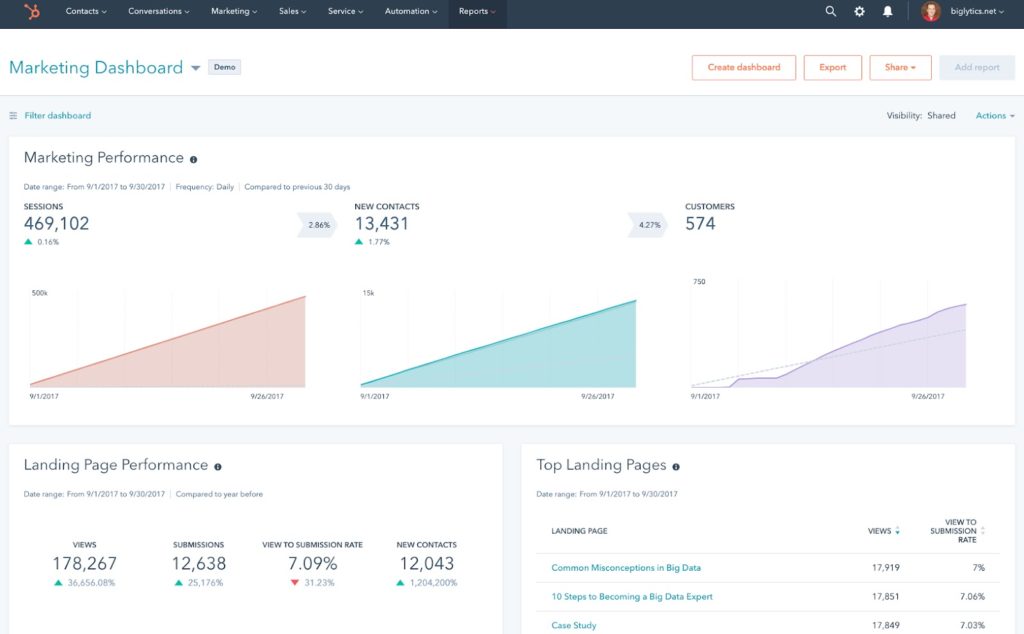
Features
- All-in-one marketing automation platform with email marketing capabilities;
- Personalization features for tailored email campaigns;
- Powerful CRM system for managing customer interactions;
- Landing page builder and conversion tracking.
Pros & Cons
| Pros | Cons |
| Extensive range of features | Steep learning curve for beginners |
| Seamless integration with HubSpot’s CRM | Unreasonably high pricing structure |
| Powerful automation and personalization capabilities | Limited features on lower plans |
Pricing & Free Plan
| Plan | Cost | Limits |
| Starter | $18 per month | Up to 1000 subscribers and 5x tier contact limit for email sends; |
| Professional | $800 per month | Up to 2,000 subscribers and 10x tier contact limit for email sends; |
HubSpot only offers a 14-day trial plan to test its features. You can use it to check different features or use the free CRM.
5. ActiveCampaign – Advanced Automation for Customer Journeys
ActiveCampaign is an integrated email marketing and CRM platform that helps you monitor leads across your sales and marketing funnel. It offers many useful features to nurture leads via emails.
Best for:
- Content creators;
- Ecommerce startups;
- Coaches and consultants.

If you’re a marketer who knows how vital conversion is for a marketing campaign’s success, ActiveCampaign is your tool.
It offers advanced lead scoring capabilities, allowing you to assign scores to leads based on their interactions and engagement. This information can be used to segment your audience and send targeted emails to those most likely to convert.
You can also count on their personalization assets across multiple channels. While SendGrid primarily focuses on email, ActiveCampaign supports multi-channel marketing, including SMS marketing, social media integration, and the ability to create personalized ads on platforms like Facebook and Google.
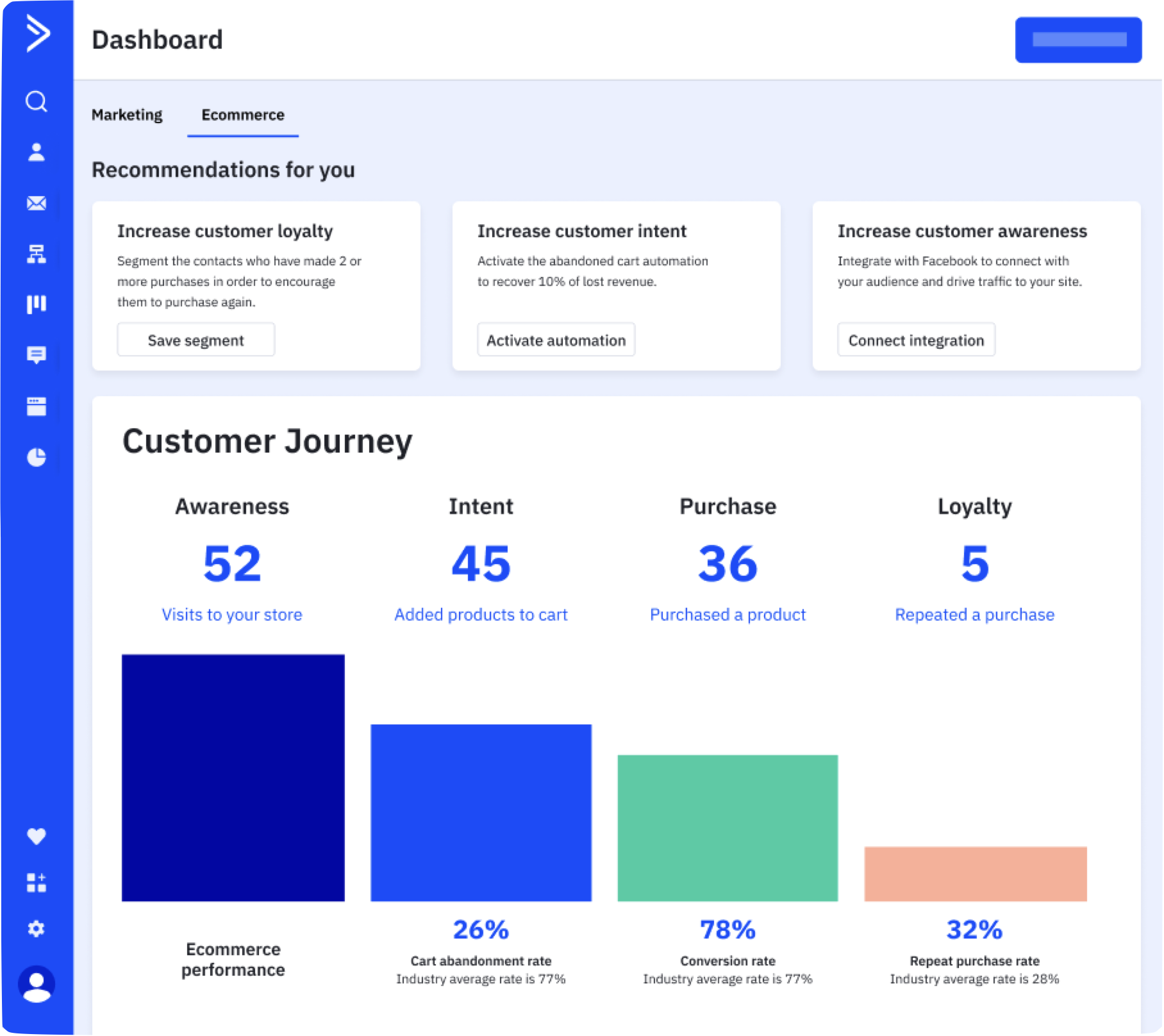
Features
- Drag-and-drop email designer with a library of customizable templates;
- Advanced automation workflows and personalization options;
- CRM system for managing customer interactions;
- Personalization & dynamic content tags.
Pros & Cons
| Pros | Cons |
| Wide variety of professionally designed email templates | Higher pricing compared to other alternatives |
| Advanced automation and personalization options | Not very beginner-friendly |
| Comprehensive CRM | Different customer service depending on pricing plans. |
Pricing & Free Plan
| Plan | Cost | Limits |
| Lite | $29/month | Up to 1,000 subscribers |
| Plus | $49/month | Up to 1,000 subscribers |
| Professional | $149/month | Up to 2,500 subscribers |
| Enterprise | $259/month | Up to 2,500 subscribers |
ActiveCampaign doesn’t have a free plan but offers a 14-day free trial.
You may also find these articles worthy of your attention:





